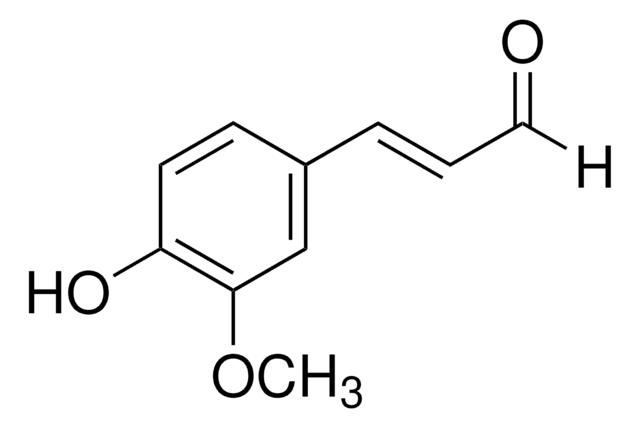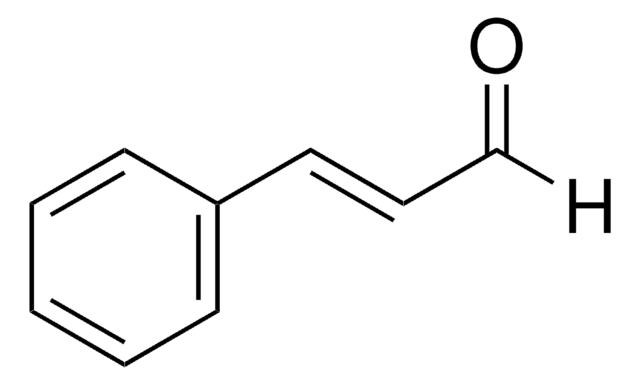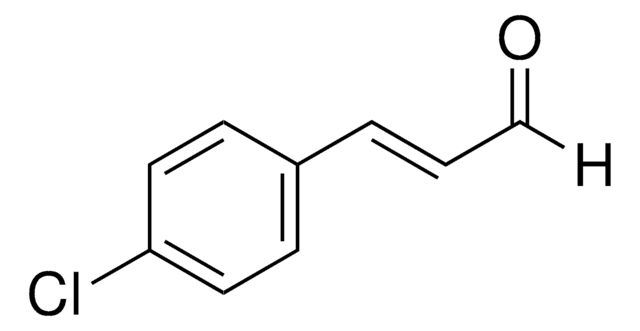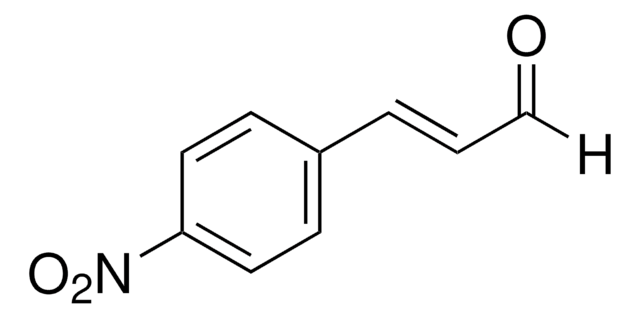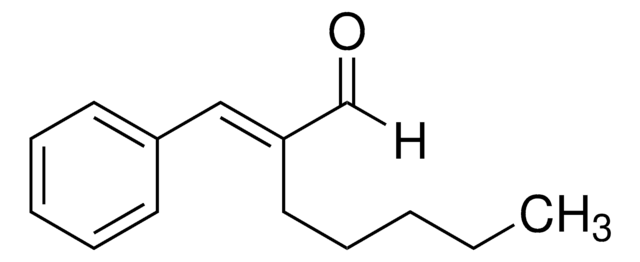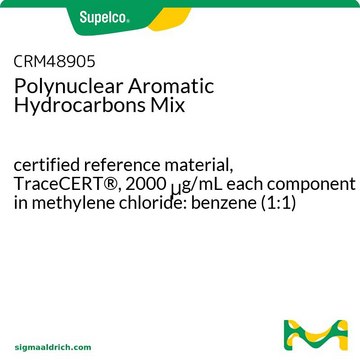모든 사진(1)
About This Item
Linear Formula:
CH3OC6H4CH=CHCHO
CAS Number:
Molecular Weight:
162.19
FEMA Number:
3181
EC Number:
유럽평의회 번호:
571
MDL number:
UNSPSC 코드:
12164502
PubChem Substance ID:
플래비스(Flavis) 번호:
5.048
NACRES:
NA.21
감각 수용성의:
cinnamon; woody; spicy; sweet
Grade:
FG
Fragrance grade
Halal
Kosher
natural
Fragrance grade
Halal
Kosher
natural
Agency:
follows IFRA guidelines
식품 알레르기항원:
no known allergens
추천 제품
Grade
FG
Fragrance grade
Halal
Kosher
natural
Quality Level
Agency
follows IFRA guidelines
규정 준수
EU Regulation 1223/2009
EU Regulation 1334/2008 & 178/2002
FDA 21 CFR 172.515
분석
98%
bp
160-161 °C/12 mmHg (lit.)
mp
44.0-49.0 °C (lit.)
응용 분야
flavors and fragrances
문건
see Safety & Documentation for available documents
식품 알레르기항원
no known allergens
향수 알레르기항원
no known allergens
감각 수용성의
cinnamon; woody; spicy; sweet
SMILES string
[H]C(=O)C=Cc1ccccc1OC
InChI
1S/C10H10O2/c1-12-10-7-3-2-5-9(10)6-4-8-11/h2-8H,1H3/b6-4+
InChI key
KKVZAVRSVHUSPL-GQCTYLIASA-N
유사한 제품을 찾으십니까? 방문 제품 비교 안내
관련 카테고리
애플리케이션
- Network pharmacology combined with molecular docking and experimental validation to explore the potential mechanism of Cinnamomi ramulus against ankylosing spondylitis.: This study investigates the anti-inflammatory potential of 2-Methoxycinnamaldehyde in Cinnamomi ramulus. Its application extends to novel therapeutic approaches for treating ankylosing spondylitis, demonstrating significant implications for medicinal chemistry and pharmacology (Wei et al., 2023).
- Ramulus Cinnamomi essential oil exerts an anti-inflammatory effect on RAW264.7 cells through N-acylethanolamine acid amidase inhibition.: The study elaborates on the anti-inflammatory activities of 2-Methoxycinnamaldehyde, offering a biochemical pathway that could be exploited in anti-inflammatory drug design (Jia et al., 2023).
- Metabolomics-Driven Exploration of the Antibacterial Activity and Mechanism of 2-Methoxycinnamaldehyde.: This article offers insights into the antibacterial properties of 2-Methoxycinnamaldehyde, using metabolomics to explore its mechanism of action, significant for developments in antimicrobial treatments (Qian et al., 2022).
신호어
Warning
유해 및 위험 성명서
Hazard Classifications
Eye Irrit. 2 - Skin Irrit. 2 - STOT SE 3
표적 기관
Respiratory system
Storage Class Code
11 - Combustible Solids
WGK
WGK 2
Flash Point (°F)
235.4 °F
Flash Point (°C)
113 °C
이미 열람한 고객
Jian-you Guo et al.
Zhongguo Zhong yao za zhi = Zhongguo zhongyao zazhi = China journal of Chinese materia medica, 31(13), 1087-1090 (2006-10-20)
To observe the effect of 2-methoxycinnamaldehyde (isolated from fraction A of Guizhi Tang) on activity of COX and PGE2 release in rat cerebral microvascular endothelial cells (rCMEC) stimulated by IL-1. rCMEC were cultured, and identified by immunohistochemistry for von Willebrand
R Giordani et al.
Phytotherapy research : PTR, 20(1), 58-61 (2006-01-07)
The antifungal activity of the essential oil from Cinnamomum cassia, alone or combined with amphotericin B, a drug widely used for most indications despite side-effects was investigated. The composition of the oil was analysed by GC/MS and characterized by its
O B Samuelsen et al.
Xenobiotica; the fate of foreign compounds in biological systems, 16(9), 845-852 (1986-09-01)
The metabolism of o-methoxycinnamaldehyde (1.3 mmol/kg, intragastrically) was studied in rats. Identification of the urinary metabolites by g.l.c.-mass spectrometry and quantification by h.p.l.c. showed that the major metabolic pathway (approx. two-thirds of the dose) was oxidation to the corresponding cinnamic
R Montes-Belmont et al.
Journal of food protection, 61(5), 616-619 (1998-08-26)
The effects of 11 plant essential oils for maize kernel protection against Aspergillus flavus were studied. Tests were conducted to determine optimal levels of dosages for maize protection, effects of combinations of essential oils, and residual effects and toxicity of
Guang-Ping Lv et al.
Journal of separation science, 33(15), 2341-2348 (2010-06-24)
A pressurized liquid extraction and GC-MS method was developed for simultaneous quantitative determination of the seven components, including cinnamaldehyde, copaene, cinnamic acid, coumarin, 2-methoxycinnamaldehyde, 2-methoxycinnamic acid and safrole in Cinnamomum cassia. The results showed that methanol and ethanol was not
자사의 과학자팀은 생명 과학, 재료 과학, 화학 합성, 크로마토그래피, 분석 및 기타 많은 영역을 포함한 모든 과학 분야에 경험이 있습니다..
고객지원팀으로 연락바랍니다.